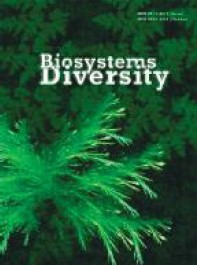The quantitative composition of micromycetes under cereal crops in chernozem soils in the Left-Bank Forest Steppe of Ukraine
The quantitative composition of micromycetes under cereal crops in chernozem soils in the Left-Bank Forest Steppe of Ukraine
Author(s): I.V. Beznosko, T. M. Gorgan, I. I. Mosiychuk, L. V. Havruliuk, O. I. BuniakSubject(s): Physical Geopgraphy, Environmental Geography
Published by: Дніпропетровський національний університет імені Олеся Гончара
Keywords: soil mycobiota; agrocenosis; number of micromycetes; hydrothermal coefficient; the root secretions of the plants; correlation coefficient;
Summary/Abstract: Soil microorganisms are an important component of agrocenoses, which due to physiological and genetic features respond quickly to changes in the quality of the soil environment. Each plant in the rhizosphere forms a specific composition of the microflora which depends on the phase of plant development and soil-climatic conditions. The objective of our study was the quantitative composition of ecological and trophic groups of rhizosphere soil micromycetes of different crops in chernozem soils in the Left-Bank Forest Steppe of Ukraine. According to the results of research, it was determined that the rhizosphere soil under different crops – winter wheat, rye and oats in Chernihiv region – is characterized by the largest number of pedotrophic micromycetes. This indicates that the soil contains a sufficient amount of organic matter. The rhizosphere soils under winter wheat and spring barley in Kiev region were characterized by a larger number of pathogenic micromycetes and amylolytic and cellulolytic ecological-trophic groups. This indicates the intensive use of plant protection products. The rhizosphere soil under onions in experimental fields in Kharkiv region was characterized by a high number of the cellulolytic group. This indicates the presence of cellulose destroying microorganisms. According to the results of statistical analysis, it was found that the number of micromycetes in the rhizosphere soil of the studied varieties of crops was in direct correlation with the value of the hydrothermal coefficient (НTC) in the vegetation period. Weather conditions during the research vegetation period differed by agrometeorological indicators. The characteristic feature was a contrast of differences in air temperature and unequal distribution of rainfall, which affected the composition of the soil mycobiocenosis. The vegetation period of 2021 in Kyiv region was characterized by a sufficiently moist hydrothermal coefficient which increased to1.81 while in Chernihiv, Kharkiv regions drought prevailed, but in some months the HTC increased to 1.32–1.54. It has been shown that the higher the HTC, the greater the number of micromycetes in all study regions.
Journal: Biosystems Diversity
- Issue Year: 30/2022
- Issue No: 2
- Page Range: 143-149
- Page Count: 7
- Language: English

